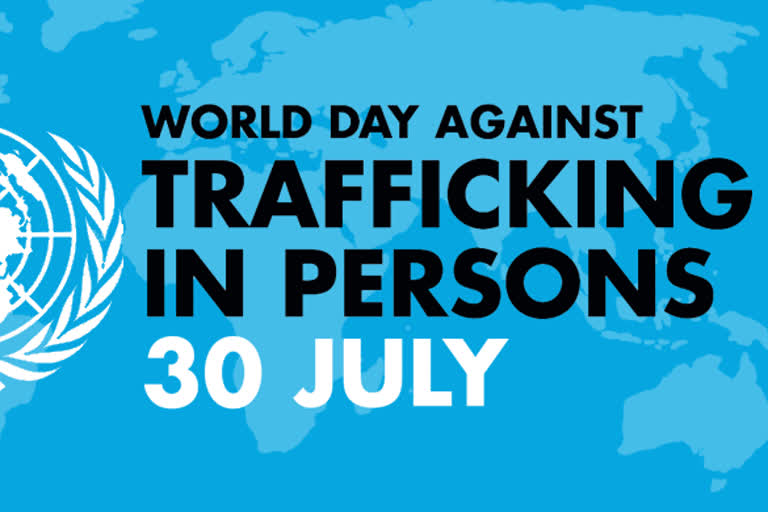Hyderabad:The illicit trade of human lives is happening right under our noses every day. It is primarily affecting the lives of millions of women and children.
World Day Against Trafficking in Persons is observed every year on July 30. On this awareness is created around fellow humans who are being trafficked and taken away against their will.
This day was started by the United Nations as a way to combat the problems that are caused due to trafficking. The resolution had declared that observance of the day is necessary to raise awareness of the situation of victims of human trafficking and for promotion and protection of their rights.
Know about 'World Day against Trafficking in persons' What is human trafficking?
According to the United Nations, human trafficking is defined as "the recruitment, transportation, transfer, harbouring or receipt of persons, by means of threat or use of force or other forms of coercion, of abduction, of fraud, of deception, of the abuse of power or of a position of vulnerability or of the giving or
receiving of payments or benefits to achieve the consent of a person having control over another person, for the purpose of exploitation.
Human trafficking is a heinous crime that affects every region of the world. Some 72 per cent of detected victims are women and girls, and the percentage of child victims has more than doubled from 2004 to 2016, according to the UN Office on Drugs and Crime (UNODC).
Human Trafficking in India
Human trafficking in India may affect between 20 and 65 million people. Women and girls are trafficked within the country for the purposes of commercial sexual exploitation and forced marriage, especially in those areas where the sex ratio is highly skewed in favour of men.
A significant number of children are subjected to forced labour as factory workers, domestic servants, beggars, and agriculture workers, while others have been used as child soldiers by insurgent or terrorist groups.
The constitutional & legislative provisions related to Trafficking in India
Human Trafficking in India Anti Trafficking Cell (ATC):Anti-Trafficking Nodal Cell was set up in the Ministry of Home Affairs (MHA) (CS Division in 2006 to act as a focal point for communicating various decisions and follow up on action taken by the State Governments to combat the crime of Human Trafficking.
The Anti-Trafficking Bill is introduced by Union minister Menka Gandhi in 2018. The bill was passed in loksabha but the bill got lapsed because Rajya Sabha did not pass it.
The legislation proposes to create institutional mechanisms at the district, state and central levels.
It calls for punishment ranging from 10 years of rigorous imprisonment and a fine not less than Rs 1 lakh for aggravated forms of trafficking, which include buying or selling of persons for the purpose of bonded labour, bearing a child, as well as those where chemical substances or hormones are administered, and a survivor acquires life-threatening illnesses such as AIDS.
Know about 'World Day against Trafficking in persons' The Bill proposes establishing a National Anti-Trafficking Bureau (NATB) for coordinating, monitoring and surveillance of trafficking cases.
It also provides for a Relief and Rehabilitation Committee and Rehabilitation Fund with an initial allocation of Rs 10 crores. It prescribes forfeiture of property used or likely to be used for the commission of an offence.
Current Situation In India
Human Trafficking in India - The Ministry of Home Affairs has provided financial assistance to the States for setting up Anti Human Trafficking Units (AHTUs) in 332 districts.
- The total number of children reported missing to NCRB by States and UTS during the year 2018 was 67134.
- National Investigation Agency (Amendment) Act 2019, has been empowered National Investigation Agency to investigate cases under Section 370 and 370A of Indian Penal Code, relating to Human Trafficking.
- The Government has also approved financial assistance to States and UTs for setting up/strengthening Anti Human Trafficking Units (AHTUs) in all Districts of States and UTs at a cost of Rs.100 crore under Nirbhaya Fund.
- According to a report from the United Nations Office on Drugs and Crime (UNODC), the vast majority of all human trafficking victims – some 71 per cent – are women and girls and one third are children.
- Maharashtra registered maximum number of missing women during the year 2016, 2017 and 2018 followed by West Bengal, Madhya Pradesh and Delhi.
COVID effect on trafficked persons
- The COVID-19 is exacerbating the vulnerabilities of children to sexual exploitation. The closure of schools could heighten the risk of online sexual exploitation.
- Risk of trafficking in mixed migration movements.
- The COVID-19 outbreak is impacting people all around the world, disrupting economic activities, State functions, livelihood options and it is reshaping global dynamics. People who were already vulnerable might become even more vulnerable to traffickers who are exploiting global uncertainties to gain profits.
- Individuals who are experiencing material, social and economic losses due to COVID Pandemic might find themselves at higher risks of trafficking and other human rights violations.
- Due to total or partial lockdown in various countries, trafficked persons get trapped in their place of exploitation and unable to find an escape.
- Trafficked persons might experience increased violence and forced work for long hours in unsafe conditions, without adequate health protections by their traffickers due to the loss of economic opportunities.
- Traffickers might detain their documents, therefore hampering the ability to access social protection, benefits and health care. Without the appropriate documentation, they might also risk to be detained and therefore, be exposed to further risks of re-victimization.
- Law enforcement’s efforts are focused on the prevention of COVID-19’s spread and leaving victims of trafficking who are waiting for a judgment in an undetermined limbo.
ALSO READ:Vande Bharat Mission: Flight carrying 145 Indians lands at Indore Airport
